White Room
2016, Geukens & De Vil, Antwerp
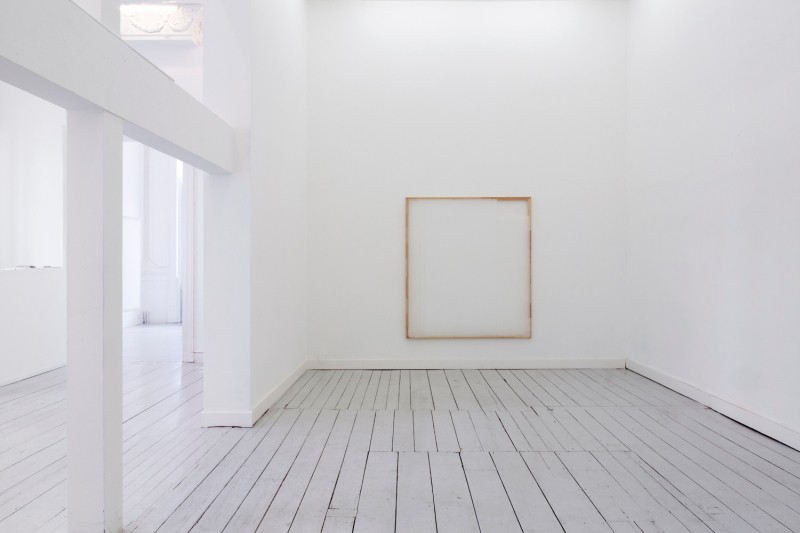

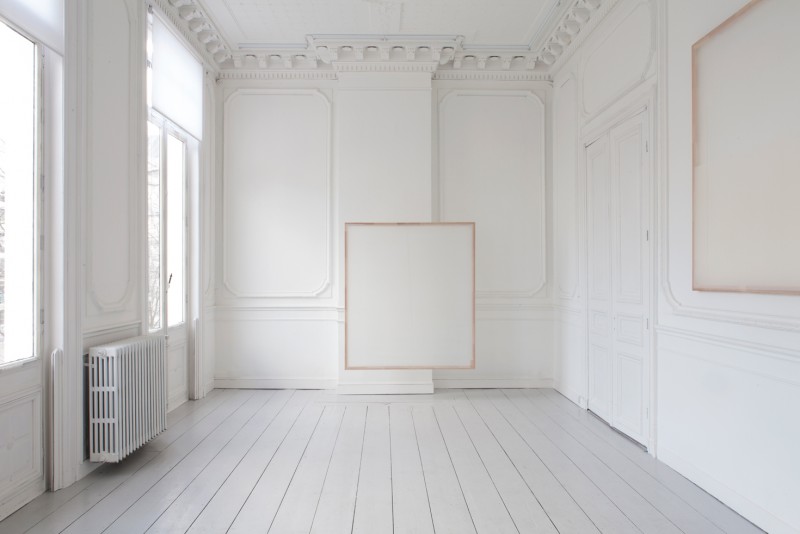
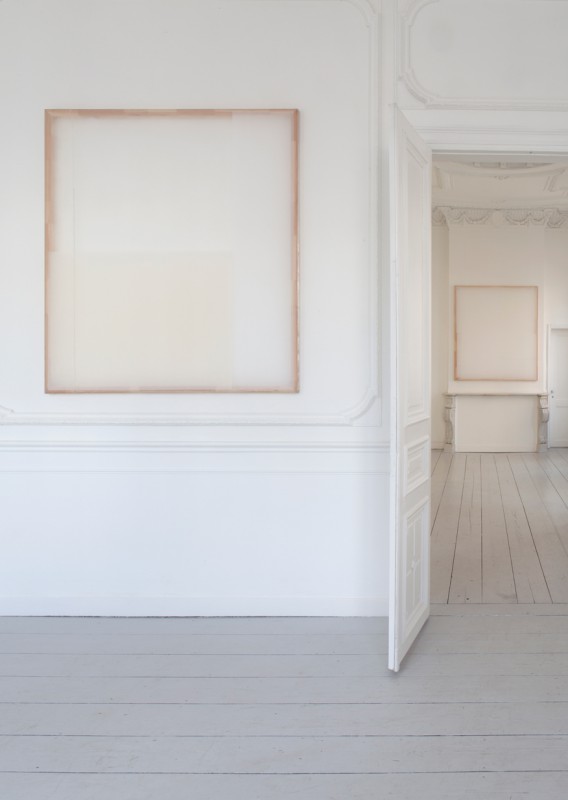

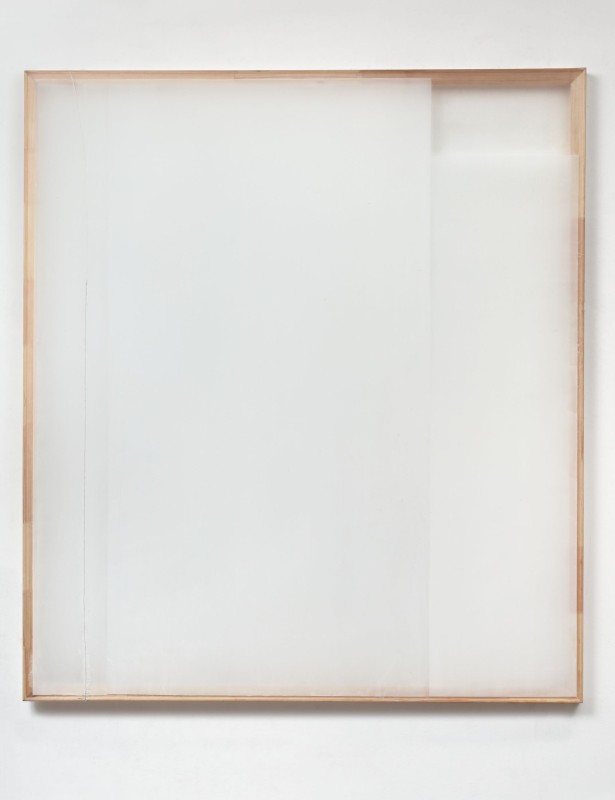
Untitled, 2016, acrylic on synthetic organza, 180 x 160 cm
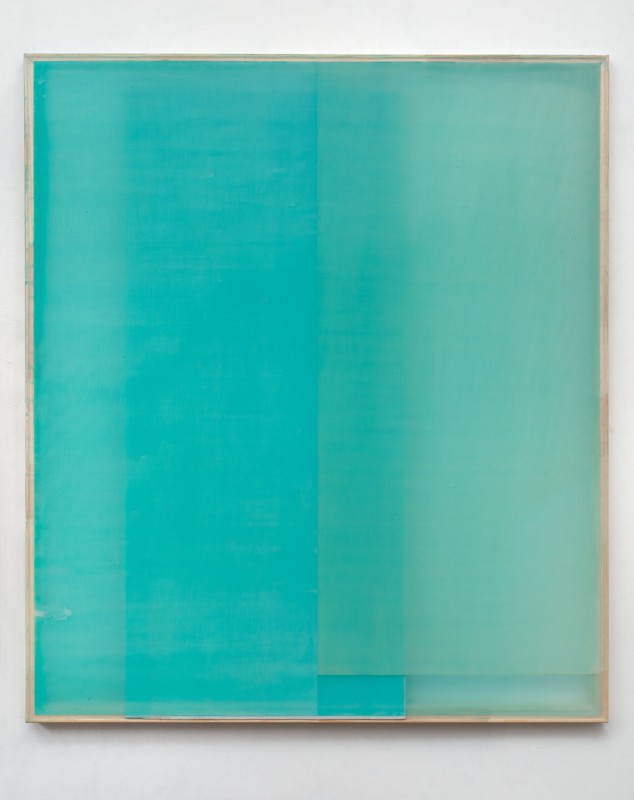
Untitled, 2016, acrylic on synthetic organza, fiberboard, paper, 160 x 140 cm
Photography: We Document Art and Martin Polák
Look, experience and look again
‘What you see is what you see.’ What Frank Stella, a leading figure in Minimal Art, meant by this was that his paintings consist only of what you see – they are objects. This also applies, but somehow at the same time does not, to the paintings of Jaromír Novotný. ‘White Room’, his solo exhibition at the Geukens & De Vil Gallery in Antwerp in 2016, looks fairly minimal. What you see is what you see. But what do you see? A white room, that’s true, with the accompanying associations of restful serenity. The walls of the gallery are white and most of the paintings are pale. The support is synthetic organza stretched on a wooden frame. This makes the paintings transparent and able to breathe. They are all different compositions, with subtle distinctions and gentle shifts between one and the other. Deceptively serene, because it seems a dark side also makes itself visible.
Look, experience and look again: you do this as automatically as breathing. Sharply defined planes are painted on the organza. Always in paint highly diluted with water. These shades of white are accompanied by degrees of transparency, and at some places there is also a piece of unpainted cloth. Yes, it is painting, but it is also a construction. Here and there you can see a piece of wood behind the cloth. It may even be a fairly large panel, and in this case you do not always grasp immediately what you can see. Novotný shows clearly and openly how his work is made. But he does slightly mislead us too. Are they shaky pencil lines, applied with extreme sensitivity? If you go up very close, you see here and there that horizontal and vertical lines have been sewn by hand. Using black thread, and elsewhere with white thread. Immensely tactile.
In 2016, abstraction is no longer in danger of extinction. For the last fifteen years or so, young artists have been giving it new substance, and Novotný is one of them. Seeing his pale works, one is soon reminded of milk-glass. The format and the presentation, sometimes distanced from the wall, also help to see these works as windows. An architectural element and a well-known metaphor in painting: the painting as a window on reality. Windows on life? Or on painting? It is also easy to be reminded of the tradition of Constructivism, Malevitch’s white square, Minimal Art, fundamental painting, the white works by the Zero group and their need to turn over a new leaf, to start from scratch again, with a clean slate.
Starting again, from absolutely nothing, over and over again, in each painting. It seems to me that Jaromír Novotný is trying to do something like this. But is it really possible to start all over again? In Harold Pinter’s play Betrayal, this great master of absurd theatre offers a memorable passage on restarting and stopping – though in this case it is about the end of a relationship. The discussion is about starting again, which is not possible because the couple had already started a long time ago, and then you can’t start all over again. You can stop again, however. This is contradicted: ‘You can only stop once.’ Which is promptly denied: ‘No, you can stop once and then you can stop again.’ I’m curious about the way Novotný tackles his work.
Do you start again in each painting, right from the beginning?
‘I start from scratch, yes. I always need a reason to do another white painting. It may be something small that differs from a previous work. In that sense it’s not really starting from scratch, because it always starts from a slightly transformed idea that emerges from what I had done before. I don’t start on a series with a predetermined plan. But I do start from an idea or a basic plan for each individual work. Usually it’s the case that the works seem to form a series only afterwards. Start from scratch, yes, but it’s impossible to start from absolute zero, from total perfection or anything like that. We just have to accept that.’
It’s a serious change from the dark paintings with architectural motifs in 2008 to the recent paintings on organza. Is it becoming more and more an analytical study of what painting can be? Or is it a quest for an increase in sensory impact?
‘It is not a planned study. It gradually became pointless for me to think in terms of abstraction and so on. Because if you do that you start to carry out certain programmes. So this evolution means liberating myself from such stressful questions as: ‘Can I make a monochrome, something that has been done so often before?’ To answer your question: it is not the one or the other, it may be a matter of approaches to painting and/or sensory phenomena. Or many other things. Time, for example. The working process requires time: getting everything ready, starting, seeing what happens, intervening, accepting chance events, deciding when it is finished, and so on. And this process is also fixed in the result.’
The viewer almost inevitably tries to figure out how the work is linked to Minimal Art and other movements rooted in Modernism. It would not be out of place in a Zero exhibition, but it would be a little incongruous. Does it incorporate any deliberate references to those historical movements?
‘No, I don’t use such references as a concept. Of course we grow up in a particular cultural environment, and it is impossible to be cut off from that. Even if it was my intention, which to a great extent it is, to make work that is perceived by the feelings, it is impossible to do only that. There are indeed connections with the movements you mention, but my feeling is that they occur in a more emotional, chance, organic way. I am not a conscious follower of any modernist theory or utopia. Nor of a break with tradition as is the case in Minimal Art.’
Why use synthetic organza and how did this series start?
‘In about 2011, when I was painting with black and white acrylic paint on canvas, I started thinking about the thick layers of paint that were needed for a black area. There was also an intermezzo with photographic paper, where the black and the white were equally material or immaterial. Organza gave the white a different dimension. By the way, changing one’s support is a good way of starting all over again. It influences the way you paint. It’s not new, of course. Polke used organza, and several other artists. The fact that the stretcher is visible is a sort of side-effect in my work. That’s not what it’s about.’
You mount bits of wood and sometimes even large panels behind the thin fabric. Is it recycled wood?
‘It doesn’t matter whether it is old or new. What is important is that I find it when I need it. If it is incorporated and it starts to work, that specific piece with its minor irregularities of form and colour lead to the completion of the work. Putting things behind the screen of the painting is just another way of painting. It doesn’t matter how the colour field is created.’
You make very sparing use of colour, but there is a green painting and a yellow painting. How do you choose the colours?
‘Making use of the colour of the fabric is a logical choice. That’s where the beige, the ochre and the yellowish-brown come from. Why this oxidized-copper green? I don’t know. Someone told me a quote from Otto Zitko, who said that he used orange because it has the fewest symbolic meanings. It may be something like that: an intense colour with no immediate clear associations. I don’t use vivid colours too often either, because I think that then you first see the colour. The attention one pays to the delicate texture, the thin lines and the imperfections are then all overshadowed by the colour.’
Synthetic organza is sold in fabric shops by the metre at a lower price that silk organza. The fabric is used for clothes, curtains, decoration and all sorts of things. Bits and pieces of wood that you add at the back also come straight from everyday reality. Are these materials intended to slightly close the gap between art and life, by linking painting with the real world?
‘I like going to ordinary shops, not for art materials, and I like to buy things that people may use for some other purpose. The next step might be not to buy stretchers for paintings, but to make them myself. But now there is a sort of balance between artistic and non-artistic materials. Yes, to some extent it is a matter of the gap between art and life. On the other hand, I don’t make a principle of it, because in essence art and life are not separated.
Sewing is a domestic activity, and another way of introducing everyday life. But at the same time I associate these sewn lines with stitched wounds and surgery. Is that the intention?
‘It is not my intention to refer to surgery, but people do see that in it. Perhaps it’s because I sew things together and the surface is sometimes reminiscent of skin. The organza I buy is 150 cm wide. If you want to do a larger work, you have to attach a piece. I simply sew it on because that is what the material wants. I can do it myself, it’s handwork that requires time and is nicely pointless, because I could use a machine. But it gives a kind of satisfaction, something like baking a cake oneself. This new type of line is a side-effect. As soon as I realised that, I started using black thread and started making a more ‘composed’ structure with more lines by incorporating smaller remnants.’
Doing what the material wants: it is a marvellous solution. Jaromír Novotný discovered it in the work of Louis Kahn (1901-1974). This American architect advised his students to take account of what the material wants. Form is the consequence of ‘what a thing wants to be’ and ‘a space that knows what it wants to be is a room’. Kahn also found this ‘psychological will to exist’ in nature too. ‘I think a rose wants to be a rose’: this was his opinion. Novotný picked this up for his own use. In 2010 he wrote: ‘A painting knows what it wants to be’. As if it occurred quite naturally, with no appreciable intervention by the artist. It is not so simple of course. But it probably helped him rid himself of stressful questions about abstraction and monochrome.
His works on organza are completely of our time. They tie in with slow art, mindfulness, the predilection for Zen, and the new spirituality that is making advances in contemporary art. Or is it a demystification of sublime abstraction and the sacred aura? In 2013 and 2014, Novotný came up with his ‘Key Paintings’: large sheets of unstretched canvas onto which he rolled CMYK colours, the four primary colours of printer’s ink. He applied the ink thinly and more or less impersonally with a roller. This sort of laconic and fairly sobering approach to abstraction is not exceptional in present-day art. The Belgian artist Pieter Vermeersch once said: ‘I paint like a printer.’ Does Jaromír Novotný want to undermine the spiritual aura of his art?
When your work is shown in a church or monastery, it perhaps shifts more towards the spiritual, the sacred and even the sublime. Doesn’t that worry you? Because you wrote about the ‘Key Paintings’ that the production process provides a counterbalance to certain spiritual connotations in monochrome painting.
‘I experienced that in some of Wade Guyton’s works. They were done mechanically using an Epson printer, but they assume something spiritual when you look at them. I did the ‘Key Paintings’ by hand with a foam roller in a fairly uninvolved way. I found it interesting to see that you don’t need to meditate for hours to create a work which to many people seems spiritual. This tension can even be found in the recent works using white organza – simplicity and complexity combined. I am fond of situations where people speak to me about the spirituality of the work. I answer: ‘Oh, I found that amongst the rubbish’ or ‘It only took me ten minutes to do it’. I may undermine the spiritual aspect a bit, but that’s because I don’t know how to talk about it. It’s also impossible to introduce it into a work intentionally. I have nothing against it if other people see it there. But if you ask me about it, I have nothing to say.’
In your ‘White Room’ exhibition I started wondering whether the work is related to contemporary society, and with what is going on in the world. And if so, how.
‘Everything is linked to everything else. Even though I don’t show any socio-political themes, the work is always part of what is going on in the world. But even so, I don’t concentrate directly on that. In my view art is a relationship with the world. Working out how a line is made, reflecting on the proportions of a stretcher and the painted parts: it runs parallel with the way you look, think and take decisions in ‘real’ life.’
But is it really painting? In fact the architectural element that was a theme in earlier paintings has always remained. Is it shifting towards ‘extended painting’, or even to installation?
‘The interest in the space we live in, meaning architecture, has always been there. Not just space, but space with a human presence. My graduation project in the drawing department at the academy in Prague – a very open-minded course – was about my family home. It was a project that used drawings, models, photographic work and collage. I am an autodidact painter. In the architecture paintings I did in 2008 to 2009 I depicted the space we live in. Whereas now it’s a matter of creating it in paintings, as something material, an object. Unlike the past, it’s an open situation that absorbs and participates in the world and life. I also prefer to stick to the human scale, with a maximum width of 160 or 170 cm – my outspread arms – and a maximum height of 200 cm. If I have to introduce myself briefly, I call myself a painter. While one viewer may consider my work ‘extended’, another may find it ‘traditional’.
Christine Vuegen